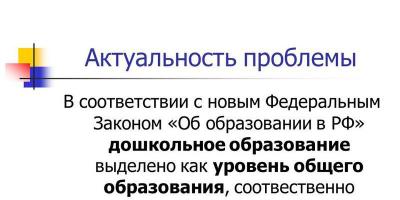Branch of MBOU Rzhaksinskaya secondary school No. 2 named after. G. A. Ponomarev in the village of Volkhonshchina
Open lesson plan
Russian language in 6th grade on the topic
“Communion and gerunds as special forms of the verb”
Teacher: Osipova M. Yu.
2013
Target:
Form a general understanding of participles and gerunds.
Tasks:
Learn to see participles and gerunds in the text, distinguish them from other parts of speech;
Consider the role of participles and gerunds in speech;
Develop students’ speech, replenish their vocabulary;
To instill in children love and respect for their native language.
Equipment:
“Russian language grade 6” by S. I. Lvova, V. V. Lvov, notebooks, pens, screen, tables, presentation “Praise of syncwine”, test tasks on the topic “Verb”.
During the classes.
- Org moment.
Hello guys. Today I will give you a Russian language lesson. My name is Maria Yurievna.
Let's listen to music and get ready for fruitful work.
(Happy music sounds)
- Repetition of the material covered on the topic “Verb”.
What can you do to this music?
(Dance, have fun, sing...)
What parts of speech did you name?
(Verbs)
Let's remember what you know about the verb. We will now conduct testing on the topic “Verb”. The computer will help us. Who wants to test their knowledge on the topic “Verb”?
(One person is called to the board)
We listen carefully, remember what we have learned, make notes on drafts, and after finishing the test we comment on it.
(Testing is carried out on a computer, which is projected on the screen, and the results are summed up)
You know the topic “Verb” well and can handle the next task without difficulty.
To complete the task that I will now give, we will divide into groups. Each group receives a card with four words. Assignment: find the fourth odd one, explain your choice.
1 card: pretended, ran, listened, smiling;
Card 2: screams, stores, turns white, reading;
Card 3: looks, cleans, peeps, shouting.
(Children find extra words: smiling, reading, shouting. Explain their choice.)
So, we found two unusual parts of speech. They are similar to a verb, but they are not verbs. And what?
III. State the topic and purpose of the lesson.
Let's write down the topic of today's lesson in our notebooks: participle and gerund as special forms of the verb. Today we will get acquainted with participles and gerunds, learn to recognize them and decide why we need them.
IV. Working on a new topic.
As you may have guessed, our extra words from the task “Find the fourth extra” are participles and gerunds. The question arises: how do you know where the participles are and where the gerunds are? Now you will learn to recognize them yourself. Open the textbook on page 35. Your task: read the theoretical material on page 35 and find out which part of speech, besides the verb, the participles are like, and which the gerunds are like.
(Independent work of children.)
While the children are working independently, the teacher writes the following words on the board:
combing his hair, playing
reading washing
sparkling running
So, what part of speech besides the verb is the gerund like?
(On an adverb, answers adverb questions.) The teacher hangs a table with adverb questions on the board.
What part of speech besides the verb is the participle similar to?
(On an adjective, answers the questions of the adjective.) The teacher hangs the questions of the adjective on the board.
Skip down a line and write down the words you see on the board in your notebooks. Determine by asking questions to the words which column contains the gerunds and which contains the participles. Label the columns.
(Children define, prove, write down.)
So, we learned that participles and gerunds are formed from the verb and are therefore called special forms of the verb. We learned to recognize participles and gerunds. But why are participles and gerunds needed? Try to answer this question by listening to the text.
Writer D. I. Grigorovich, talking about his literary endeavors, recalls that his essay “Petersburg Organ Grinders” earned the approval of F. M. Dostoevsky, but the latter did not like one place in the chapter “The Organ Grinder’s Public”. “For me,” writes Grigorovich, “it was written like this: When the organ grinder stops playing, the official throws a nickel from the window, which falls at the feet of the organ grinder. “Not that, not that,” Dostoevsky suddenly spoke irritably, “not that at all!” You sound too dry: the nickel fell at your feet... You should have said: the nickel fell on the pavement, ringing and bouncing...” This remark - I remember very well - was a revelation for me. Yes, indeed, ringing and bouncing - it turns out much more picturesque, it completes the movement...”
So, guys, why do we need participles and gerunds?
(They make our speech more picturesque.)
We found out everything we were going to find out in today's lesson. And to summarize the lesson, we will now come up with a syncwine.
(Vocabulary work is carried out using the presentation “Praise of syncwine” and a syncwine is compiled on the topic “Communications”)
Sinkwine
1. Participle
2.Special, unchangeable.
3. Designates, forms, combines.
4. Makes speech figurative and expressive.
5.Form.
V. Lesson summary. D/z.
Reflection: What new did you learn in today's lesson?
Grading.
Homework: come up with a cinquain on the topic “Communion.”
Preview:
To use presentation previews, create a Google account and log in to it: https://accounts.google.com
Slide captions:
Preview:
Open Russian language lesson in 5th grade.
Lesson topic: “Repetition of what was learned in the “Lexicology and Phraseology” section.”
Goals:
Generalization and systematization of knowledge gained in the process of studying this topic;
Enrichment of students' vocabulary;
Formation of the ability to use words in speech in accordance with their lexical meaning;
Arouse personal interest in the subject; cultivate a creative personality.
Equipment : textbook "Russian language. Practice. 5th grade" ed. V.V. Babaytseva, dictionaries, cards, crossword.
During the classes:
1.Organizing moment.
Teacher: Good afternoon, guys. Look what a wonderful spring day it is today. Let's smile at each other. I am pleased to see your faces, your smiles, and I think that today’s lesson will bring everyone the joy of communicating with each other. Our lesson is devoted to reviewing what has been learned on the topic “Lexicology and Phraseology.” (Record the date and topic of the lesson).
2.Work on the topic.
1) Goal setting:
Teacher: guys, carefully read the epigraph of today's lesson. This is a poem by the poet Kozlovsky.
Words can cry and laugh,
Command, pray and conjure,
And, like a heart, it bleeds,
And breathe the cold indifferently.
A call to become, and a response, and a call
The word is capable of changing its mode.
And they curse and swear by word,
They admonish, glorify, and denigrate.
Who is the main character of this poem? (Word). This is what we will talk about in today's lesson. I’ll say right away that our lesson will be extraordinary. Do you love to travel? Today we will take a fabulous journey to the islands and peninsulas of the amazing sea of Lexica. What should we take with us so as not to get lost? (Compass.) Your knowledge will serve as a compass. Like any fairy tale, our lesson begins with magic. Close your eyes and imagine: the sea, the waves splashing.
The wind blows across the sea,
And the boat speeds up,
He runs in the waves
With sails raised.
2) But our ship is large, and it cannot sail only with the help of the wind. You need to “start” it. And since our lesson is a fairy tale, the ship can only be “started” in a fairy tale way. The ship will begin its journey only when you tell everything you know about the vocabulary. So what is vocabulary?
What is the name of the branch of linguistics that studies the lexical composition of a language? (lexicology).
We know that every word means something. Match the word and its lexical meaning.
Rude, ill-mannered man battle
Workshop for repair and production of clothes, shoes, firewood
Big, important battle, battle of the studio
Pieces of wood used to heat a square oven
A rectangle whose sides are equal
And so that we don’t get bored surfing the waves of the sea, you can find dictionaries in the cabin. Here are Russian language dictionaries. Each of them contains words, but they are viewed from different angles. Dictionaries reflect the vocabulary richness of a language. Here we see explanatory dictionaries, a dictionary of synonyms and antonyms. These dictionaries can be your friends and helpers.
3) Well, now we begin the journey.
Read this poetic passage carefully and answer the question: Why did the ship run away, but the ship was ordered to land? If you are at a loss, consult a dictionary.
The wind is making a cheerful noise, now visible from a distance.
The ship is running merrily, guns are firing from the pier,
Past the island of the brawler... The ship is ordered to land.
And a familiar country
Students (read the definition from dictionaries) “Ship” and “ship” are synonymous words; they are used for greater expressiveness.
Teacher. What else did you notice? (ship is a polysemantic word).What common meaning do the words “ship” and “ship” have? (a vehicle for transporting goods and people).
Teacher. So we met the first inhabitants of the magical land of Synonyms. What are synonyms? (these are words that are close in meaning, but different in sound and spelling). In order not to anger the inhabitants of the island, and so that they show us the way further, we will fulfill their request - we will complete the tasks.
Students receive a task: listen to poetic passages and complete the sentences with words that are appropriate in meaning. (Write in notebooks)
1) Simple word interval:
A few minutes in the theater
Until a new act begins
We call everything... (intermission - a short break between the actions of a performance or sections of a concert).
2) In the struggle, in the work, too tired,
They give the tired...(a respite - a short break.)
3) After the lesson without fail
The kids need...(recess - break between lessons).
4) Having stopped something for a while,
We announce...(break)
Teacher. What are these words? (Synonyms). What are synonyms for? Maybe you can do without them? (They are widely used in speech, in works of art. Literatures to convey shades of thoughts, to make speech accurate and expressive and to avoid repetition, enrich our speech, make it more diverse.)
4 ) So we have passed the kingdom of Synonyms. It's time to move on. Our path lies to the Omonimov Peninsula. But somehow it seems to me that we have lost our way a little.
Oh, guys, look, there is some kind of note in front of us. Let's read it. “Dear explorer travelers! We welcome you to our kingdom. We suggest finding out the meaning of the following words: heat - cold. (Heat - hot, very heated air, heat; cold - low temperature air). Now name our kingdom..? That's right, you and I found ourselves in the kingdom of Antonyms. What are antonyms? (Words of the same part of speech with opposite lexical meanings.) We will have a little trouble with these kings, because they are at enmity all the time. Let's try to get them interested in solving a crossword puzzle. We work in pairs. Guys, only after solving the crossword puzzle will we be able to visit the antonyms. You have some pieces of paper with a crossword puzzle.
Fill it out with antonyms for the words below. If everything is correct, then the crossword will serve as the key to enter. One at the board.
1.Paradise. 2.Despair. 3. Light. 4.Approval. 5..End. 6.Lie. 7. Quarrel.
5 )Teacher. Let's take a break, a break, a break.
Our rest is a physical education minute,
Take your seats:
Once they sat down, twice they stood up.
Everyone raised their hands up.
They sat down, stood up, sat down, stood up,
It’s as if they became Vanka-vstanka.
And then they started galloping (jumping in place)
Like my elastic ball.
6) The kings are pleased with us and give us permission to continue our journey. And now we are approaching the amazing peninsula - Omonimov. But they can let us through only if you remember what kind of mysterious inhabitants live here.
We are words from Russian speech,
From your native language!
They hear us equally
They write us the same way.
But not only appearance is important,
So take your time,
Haste is not always necessary
You get to the meaning. Like a filling
The meaning is hidden in the middle,
Similar persons in spite of
We are far away in meaning.
Homonyms are words that are identical in sound and spelling, but different in lexical meaning.
There are cards in front of you; in your notebook you only need to write down the answer to what this word means.
- Plant, weapon (bow); 2) plant, clown (parsley); 3) hair, tool (braid); 4) dishes, headdress (kettle); 5) animals, mushrooms (chanterelles).
7) Teacher. Next, our ship moored to small islands. In the conversation of the inhabitants of the first island you can hear words such as: chain mail, hussar, eye, right hand. What is the name of the island? (Island of obsolete words)
8) And on the neighboring island there are words that make us smile when we hear them, such as: kochet, kazyuli, beetroot. What kind of island is this? (Island of dialect words)
9) Well, the last island is characterized by the following words: advance, barter, computer and others. How many of you guessed what it's called? What are neologisms?
Now we will play the game “Who is faster?” You need to write as many neologisms as possible in 1 minute. So, get ready, let's start!
10) Through a small isthmus we find ourselves in the country of Phraseology. What is phraseology? Phraseologism? Write down phraseological units and explain their meanings:
Nod off (fall asleep), put a spoke in the wheels (get in the way), throw words into the wind (promise in vain), play dumb (do nothing), run headlong (fast), there is nowhere for an apple to fall (a lot), know it by heart (good).
3. Summing up the lesson.
Teacher. Unfortunately, good things always come to an end. Our journey is coming to an end. And our ship is hurrying back. All we have to do is remember once again what words are studied in vocabulary?
4. Assessment of student knowledge.
1)Paradise. 2) Despair. 3) Light. 4) Statement. 5) The end. 6) Lie. 7) Quarrel
Cinquain was invented at the beginning of the 20th century by Adelaide Crapsey, an American poet. Inspired by Japanese haiku and tanka, Crapsey came up with a five-line poem form, also based on counting the syllables in each line. The traditional one she invented had a syllable structure of 2-4-6-8-2 (two syllables in the first line, four in the second, and so on). Thus, the poem should have had 22 syllables in total.
Didactic syncwine was first used in American schools. Its difference from all other types of syncwine is that it is based not on counting syllables, but on the semantic specificity of each line.
The classic (strict) didactic syncwine is structured like this:
, one word, noun or pronoun;
second line – two adjectives or participles, which describe the properties of the topic;
third line - or gerunds, telling about the actions of the topic;
fourth line – four word sentence, expressing the personal attitude of the author of the syncwine to the topic;
fifth line – one word(any part of speech) expressing the essence of the topic; a kind of resume.
The result is a short, unrhymed poem that can be devoted to any topic.
At the same time, in a didactic syncwine, you can deviate from the rules, for example, the main topic or summary can be formulated not in one word, but in a phrase, a phrase can consist of three to five words, and actions can be described in compound words.
Compiling a syncwine
Coming up with syncwines is quite a fun and creative activity, and it does not require special knowledge or literary talents. The main thing is to master the form well and “feel” it.
For training, it is best to take as a topic something well-known, close and understandable to the author. And start with simple things. For example, let’s try to create a syncwine using the topic “soap” as an example.
Respectively, First line- "soap".
Second line– two adjectives, properties of an object. What kind of soap? You can list in your mind any adjectives that come to mind and choose two that are suitable. Moreover, it is possible to describe in syncwine both the concept of soap in general (foaming, slippery, fragrant), and the specific soap that the author uses (baby, liquid, orange, purple, etc.). Let’s say the end result is “transparent, strawberry” soap.
Third line– three actions of the item. This is where schoolchildren often have problems, especially when it comes to syncwines devoted to abstract concepts. But we must keep in mind that actions are not only the actions that an object produces in itself, but also what happens to it and the impact it has on others. For example, soap can not only lie in a soap dish and smell, it can slip out of your hands and fall, and if it gets into your eyes, it can make you cry, and most importantly, you can wash yourself with it. What else can soap do? Let's remember and choose three verbs in the end. For example, like this: “It smells, it washes, it bubbles.”
Fourth line– the author’s personal attitude to the topic of syncwine. Here, too, sometimes problems arise - what kind of personal attitude can you have towards soap if you are not a fan of cleanliness, who really loves to wash, or not, who hates soap. But in this case, personal attitude means not only the emotions that the author experiences. These could be associations, something that, in the author’s opinion, is the main thing in this subject, and some facts from the biography related to the topic of syncwine. For example, the author once slipped on soap and broke his knee. Or tried making soap yourself. Or he associates soap with the need to wash his hands before eating. All this can become the basis for the fourth line, the main thing is to put your thought into three to five words. For example: “Wash your hands before eating.” Or, if the author ever as a child tried to lick soap with a delicious smell - and was disappointed, the fourth line could be: “The smell, the taste is disgusting.”
And finally last line– summary in one or two words. Here you can re-read the resulting poem, think about the image of the object that has arisen, and try to express your feelings in one word. Or ask yourself the question - why is this item needed at all? What is the purpose of his existence? What is its main property? And the meaning of the last line greatly depends on what has already been said earlier. If the fourth line of the cinquain is about washing your hands before eating, the logical conclusion would be “cleanliness” or “hygiene.” And if the memories of a bad experience of eating soap are “disappointment” or “deception”.
What happened in the end? An example of a classic didactic syncwine of strict form.
Soap.
Transparent, strawberry.
It washes, it smells, it bubbles.
The smell is sweet, the taste is disgusting.
Disappointment.
A small but entertaining poem in which all children who have ever tasted soap will recognize themselves. And in the process of writing, we also remembered the properties and functions of soap.
After practicing on simple subjects, you can move on to more complex, but familiar topics. For training, you can try to compose a cinquain on the theme “family” or a cinquain on the theme “class”, poems dedicated to the seasons, and so on. And a cinquain on the theme “mother”, composed by primary school students, can be a good basis for a postcard in honor of the 8th of March holiday. And syncwin texts written by students on the same topic can form the basis for any class-wide projects. For example, for Victory Day or New Year, schoolchildren can make a poster or newspaper with a selection of thematic poems written in their own hand.
Why make a syncwine at school?
Compiling a syncwine is a rather exciting and creative activity, which, despite its simplicity, helps children of all ages develop systematic thinking and analytical abilities, isolate the main thing, formulate their thoughts, and expand their active vocabulary.
In order to write a cinquain, you need to have knowledge and understanding of the subject - and this, on top of everything, makes writing poems an effective form of testing knowledge in almost any subject of the school curriculum. Moreover, writing a syncwine in biology or chemistry will take less time than a full-fledged test. A cinquain in literature, dedicated to any of the literary characters or a literary genre, will require the same intensive work of thought as writing a detailed essay - but the result will be more creative and original, faster (to write a cinquain for children who have mastered the form well, it is enough 5-10 minutes) and indicative.

Sinkwine - examples in various subjects
Sinkwine in the Russian language can be devoted to different topics, in particular, you can try to describe parts of speech in this way.
An example of a syncwine on the topic “verb”:
Verb.
Returnable, perfect.
Describes an action, conjugates, commands.
In a sentence it is usually a predicate.
Part of speech.
In order to write such a syncwine, I had to remember what forms a verb has, how it changes, and what role it plays in a sentence. The description turned out to be incomplete, but nevertheless it shows that the author remembers something about verbs and understands what they are.
In biology, students can write syncwines dedicated to individual species of animals or plants. Moreover, in some cases, to write a syncwine on biology, it will be enough to master the content of one paragraph, which allows you to use the syncwine to test the knowledge acquired during the lesson.
An example of a syncwine on the theme “frog”:
Frog.
Amphibian, chordate.
Jumps, spawns, catches flies.
Sees only what moves.
Slippery.
Synquains in history and social studies allow students not only to systematize their knowledge on the topic, but also to feel the topic more deeply, “pass” it through themselves, and formulate their personal attitude through creativity.
For example, cinquain on the theme "war" could be like this:
War.
Terrible, inhumane.
Kills, ruins, burns.
My great-grandfather died in the war.
Memory.
Thus, syncwine can be used as part of the study of any subject in the school curriculum. For schoolchildren, writing thematic poems can become a kind of “creative break”, adding pleasant variety to the lesson. And the teacher, having analyzed the students’ creativity, can not only assess their knowledge and understanding of the subject of the lesson, but also feel the students’ attitude to the topic, understand what interested them most. And, perhaps, make adjustments to plans for future classes.
Composing syncwines - short, unrhymed poems - has recently become a very popular type of creative task. School students, students of advanced training courses, and participants in various trainings encounter it. As a rule, teachers ask you to come up with a syncwine on a given topic - a specific word or phrase. How to do it?

Rules for writing syncwine
Cinquain consists of five lines and, despite the fact that it is considered a type of poem, the usual components of a poetic text (the presence of rhymes and a certain rhythm) are not mandatory for it. But the number of words in each line is strictly regulated. In addition, when composing a syncwine, you must use certain parts of speech.
Synquain construction scheme is this:
- first line – syncwine theme, most often one word, a noun (sometimes the topic can be two-word phrases, abbreviations, first and last names);
- second line – two adjectives, characterizing the topic;
- third line – three verbs(actions of an object, person or concept designated as a topic);
- fourth line – four words, a complete sentence describing the author’s personal attitude to the topic;
- fifth line – one word, summing up the syncwine as a whole (conclusion, summary).
Deviations from this rigid scheme are possible: for example, the number of words in the fourth line can vary from four to five, including or not including prepositions; Instead of “lonely” adjectives or verbs, phrases with dependent nouns are used, and so on. Usually, the teacher who gives the task to compose a syncwine decides how strictly his students should adhere to the form.

How to work with the syncwine theme: first and second line
Let's look at the process of inventing and writing a syncwine using the topic “book” as an example. This word is the first line of the future poem. But a book can be completely different, so how can you characterize it? Therefore, we need to specify the topic, and the second line will help us with this.
The second line is two adjectives. What's the first thing that comes to mind when you think of a book? For example, it could be:
- paper or electronic;
- sumptuously bound and richly illustrated;
- interesting, exciting;
- boring, difficult to understand, with a bunch of formulas and diagrams;
- old, with yellowed pages and ink marks in the margins made by grandmother and so on.
The list can be endless. And here we must keep in mind that there cannot be a “correct answer” here - everyone has their own associations. Of all the options, choose the one that is most interesting to you personally. This could be an image of a specific book (for example, your favorite children's books with bright pictures) or something more abstract (for example, “books of Russian classics”).
Now write down two characteristics specifically for “your” book. For example:
- exciting, fantastic;
- boring, moralizing;
- bright, interesting;
- old, yellowed.
Thus, you already have two lines - and you already have an absolutely accurate idea of the “character” of the book you are talking about.

How to come up with the third line of syncwine
The third line is three verbs. Here, too, difficulties may arise: it would seem, what can a book “do” by itself? To be published, to be sold, to be read, to stand on the shelf... But here you can describe both the impact that the book has on the reader and what goals the author set for himself. A “boring and preachy” novel, for example, might enlighten, moralize, tire, put to sleep and so on. “Bright and interesting” book for preschoolers - entertains, interests, teaches reading. Exciting fantasy story - captivates, excites, awakens the imagination.
When choosing verbs, the main thing is not to deviate from the image that you outlined in the second line and try to avoid words with the same root. For example, if you described a book as fascinating, and in the third line you wrote that it “fascinates,” you will feel like you are “marking time.” In this case, it is better to replace one of the words with a similar meaning.
Let’s formulate the fourth line: attitude to the topic
The fourth line of the syncwine describes a “personal attitude” to the topic. This causes particular difficulties for schoolchildren who are accustomed to the fact that attitudes must be formulated directly and unambiguously (for example, “I have a good attitude towards books” or “I think books are useful for raising the cultural level”). In fact, the fourth line does not imply evaluativeness and is formulated much more freely.
In essence, here you need to briefly outline what is most important for you in the topic. This may be relevant to you personally and your life (for example, “ Began reading at age four" or " I have a huge library", or " I can't stand reading"), but this is optional. For example, if you think the main disadvantage of books is that they use a lot of paper to produce, for the production of which forests are cut down, you don’t have to write “I” and “condemn.” Just write that " paper books – tree graves" or " book production is destroying forests”, and your attitude to the topic will be quite clear.
If it is difficult for you to immediately formulate a short sentence, first express your thought in writing, without thinking about the number of words, and then think about how you can shorten the resulting sentence. As a result, instead of " I love science fiction novels so much that I often can’t stop reading them until the morning"It might turn out, for example, like this:
- I can read until the morning;
- I often read all night long;
- I saw a book - I said goodbye to sleep.
How to sum it up: the fifth line of syncwine
The task of the fifth line is to briefly, in one word, summarize all the creative work of writing a syncwine. Before you do this, rewrite the previous four lines - almost a finished poem - and re-read what you got.
For example, you thought about the variety of books, and you came up with the following:
Book.
Fiction, popular science.
Enlightens, entertains, helps.
So different, everyone has their own.
The result of this statement about the endless variety of books can be the word “library” (a place where many different publications are collected) or “diversity”.
In order to isolate this “unifying word”, you can try to formulate the main idea of the resulting poem - and, most likely, it will contain the “main word”. Or, if you are used to writing “conclusions” from essays, first formulate the conclusion in your usual form, and then highlight the main word. For example, instead of " thus we see that books are an important part of culture”, write simply – “culture”.
Another common option for the ending of a syncwine is an appeal to one’s own feelings and emotions. For example:
Book.
Fat, boring.
We study, analyze, cram.
Classic is a nightmare for every schoolchild.
Yearning.
Book.
Fantastic, fascinating.
Delights, captivates, deprives you of sleep.
I want to live in a world of magic.
Dream.

How to learn to quickly write syncwines on any topic
Compiling syncwines is a very exciting activity, but only if the form is well mastered. And the first experiments in this genre are usually difficult - in order to formulate five short lines, you have to seriously strain.
However, after you have come up with three or four syncwines and mastered the algorithm for writing them, things usually go very easily - and new poems on any topic are invented in two or three minutes.
Therefore, in order to quickly compose syncwines, it is better to practice the form on relatively simple and well-known material. For training, you can try to take, for example, your family, home, one of your relatives and friends, or a pet.
Having dealt with the first syncwine, you can work on a more complex topic: for example, write a poem dedicated to any of the emotional states (love, boredom, joy), time of day or time of year (morning, summer, October), your hobby, hometown, etc. Further.
After you write several such “test” works and learn to “package” your knowledge, ideas and emotions into a given form, you will be able to easily and quickly come up with syncwines on any topic.
“Communion in the Russian language” - In my opinion, the participle is the most rustling part of speech in the Russian language. Sacraments have a defender! What did A.S. Pushkin think about the use of participles? Get acquainted with the history of the appearance of the sacrament in the Russian literary language. Shining, from Lomonosov’s point of view, sounds beautiful, but diving is some kind of horror!
“The Master and Margarita lesson” - Immortality. Mediocrity. Work, suffer, love. The “manuscripts” of real creators “do not burn.” Black magic. Woland. Lesson II: Creative laboratory. I don't believe in hidden lamps. Teacher Goals: Judging by your questionnaires, you have almost all read the novel. The answer of the IV group is very interesting: Creator. Results of group work:
“Communion lesson” - Active and passive participles. In short passive participles, one letter “n” is written: read, told. Such words in grammar are called participles. Symbols may be offered in different colors. For example: The plucked flower has withered. - The flower was picked. In this sentence, “sky” is the word being defined.
“Lesson Communion” - Read the text. Syntactic function. Lesson 3 Check yourself: NOT with participles. Lesson 6 The pearl of Tatar music. Spelling suffixes. Punctuation for participial phrases. Training exercises for spelling participles. Lesson 7 The first production took place in 1941. Lesson topics: Goals: Formation of active participles of the present and past tense.
“Communion 10th grade” - 2. Passive participle. Passive. PARTICIPLE is a special form of a verb that denotes an attribute of an object by action. Valid. Find and write down participles, indicate the category, highlight the suffix. From the base present.V. 1. Verb 2. Passive participle 3. Adjective 4. Active participle.
“The participle as a part of speech” - Name the condition for isolating the participial phrase. What signs can appear in the text in the presence of a participial phrase? Read the sentence. What tense (as a grammatical feature) does the participle lack? What is the peculiarity of the defined words in sentences 3 and 5? The role of participles in speech. In the sentences from “Life…” find participial phrases and explain the punctuation.
1. Copy the text, inserting missing letters, punctuation marks and opening parentheses. Sort participles and gerunds according to their composition.2. Read the text expressively. Describe the picture that appears in your mind. Determine what is the role of participles and gerunds in this text.
3. What method of word formation unites the highlighted words? Prove it.
To the west, outside the city, the dawn was dawning. As if into the mouth of a red-hot, flaming...living gold volcano fell..fell heavy bluish clouds glowed (bloody) with red...amber, violet lights. And above the volcano a cloud of... rose up... green... turquoise And ak..v..m..rina meek evening spring sky.
Walking slowly along the highway, with difficulty dragging his feet in huge boots, Romashov was relentlessly staring at this magical fire. As always, since childhood, he imagined behind the bright evening dawn some kind of mysterious, holy life.
Place verbs, participles and gerunds in the vertical columns, and in the right horizontal column reflect the method of writing NOT (jointly or separately). Fill out the table with four examples, indicating in them the conditions for choosing separate or continuous spelling NOT.
1. From these verbs form all possible participles and gerunds:Create, throw away (1 option). Sell, jump out (2nd option).
2. Conduct a morphemic analysis of participles and gerunds.
Option 1: sparkling snow, drizzling rain, lowering the price, thinking about the future, a warm lunch, making your way through the thickets, an ongoing storm
Option 2: a sung song, a blue stripe of the sky, telling the truth, sitting in a car, warming tea, climbing into a hut, stiff legs
H. Compose (or select from the poems you have learned) and write down, placing punctuation marks, a sentence with a participial phrase. Select the participial phrase as a part of the sentence.
4. Compose (or select from the poems you have learned) and write down, placing punctuation marks, a sentence with an adverbial phrase. Underline the participial phrase as part of the sentence.
5. Determine in which phrase the participle is used in a figurative meaning. Compose and write down a complex sentence with a phrase in which the participle is used in its literal meaning.
Option 1: loose hair - loose children, running guys - running eyes, a shiny object - brilliant success
Option 2: open door - open soul, extinguished light bulb - extinguished smile, limited movement - limited person
6. Find errors in the use of highlighted participles and gerunds. Write down the sentences in corrected form.
1) It started to rain and confused all plans for a vacation outside the city. 2) We were given a task for the summer. H) Noticing the excitement of my interlocutor, I stopped. 4) Having eaten to my heart’s content, my mind wanted to sleep.
Level II. (3 tasks) (standard) “4” 1. Read, determine the type of participle. You need to learn good, calm, intelligent speech for a long time and carefully - listening, memorizing, noticing, reading. 2. From these imperfective and perfective verbs. Delay, think, defend, finish, stand, talk, do, look, look. 3. Compose a syncwine of your choice on the topic “Verb”, “Participation”, “Gerundial”, “Verb”.
Slide 12 from the presentation "Repetition of participles and gerunds". The size of the archive with the presentation is 1911 KB.Russian language grade 10
summary of other presentations“Preparation for the Unified State Exam in the Russian language” - Assignment for the text. My trees. Morphology. Assignments to the text. Twins. Workshop. Fine and expressive means. Preparation for execution. Satisfied man. Complicating structures. We will fight again. Beggar. Dog. Two rich men. Collocations. Words formed in different ways. One-part sentences. Sparrow. Connection of sentences in the text. Stone. Ways of word formation. Complex sentences.
“Borrowing words in Russian” - Write down words of Old Church Slavonic origin. Vocabulary composition and its formation. In terms of time of penetration, borrowed vocabulary is also heterogeneous. Vocabulary of the modern Russian language from the point of view of its origin. Find Old Church Slavonicisms. The Russian language has borrowings from other languages. Separate word-forming elements. Drawn by a simple plan, I moved along that path. The sun, like a golden seal, stands guard at the gate.
“Professional words” - Professional and terminological vocabulary. Foreign language borrowings. Professionalisms must be distinguished from terms. Various beautiful things. Dictionary of marine terms. Glossary of terms. Litters. Terminological vocabulary. How profession influences speech culture. Term. Methods of education of professionalism. Professionalisms are jargons. How to distinguish professionalisms from terms. Terms. Professionalisms and terms.
“Repetition of participles and gerunds” - Find the participle. Sinkwine. Find the participle and gerund. Type of participle. Completed task. Participle and gerund. Spotters. Multi-level tasks. Write down the proposal. Strengthen your knowledge of gerunds and participles. Updating. Complete the sentences. Informants. Answers from informants. Participle.
“Comma in a complex sentence” - A comma at the junction of two conjunctions. Airplane. Clauses of manner of action. The forest stands silent. Imagination. The night was quiet and bright. Compound sentences with disjunctive conjunctions. Comma between homogeneous subordinate clauses. Remember the songs. Dash. Mother, who stayed in the city all summer. Tree branches. In the evening we went out into the clearing. Subordinate goals. Determine the types of subordinate clauses. Complex sentences.
“Text plan for the Russian language” - Plan. Make a simple outline of the text. Change the question plan into a noun plan. What are the plans? Thesis plan. Complicated plan. Simple plan. Question plan. Outline of the text in the form of questions. Make a complex outline of the text.








